Mark Earnest's Clacier Discovery Trip Report
By Mark Earnest
Glacier Discovery Train to Spencer Glacier & Float Tour
Sunday, September 3, 2006
Whittier to Spencer Glacier and Return
The day begins with something almost unheard of in Whittier for the past six
weeks … sunshine! Whittier's rainfall total for the month of August
was nearly 30 inches. With family visiting from the Lower 48, we decide to celebrate
our good fortune by taking the Glacier Discovery Train to Spencer Glacier for
a day of rafting, in style. Spencer Glacier is located near Mile 54 of the Alaska
Railroad, about one mile from the tracks.
We arrive at the passenger boarding area at Whittier with plenty of time to
spare. The Glacier Discovery Train loads and offloads passengers at a seasonal,
tent-like structure across from the cruise ship terminal and marina. For railfans,
it is located near Bridge F1.2 (parallel 126-foot open timber trestle bridges
that cross Whittier Creek) and a 3-track grade crossing that provides access
to beautiful downtown Whittier.
Before long, GP40-2 3009 comes into view, leading the small passenger consist
into the boarding area. Conductor Wade Sherwood hands us our tickets and we
climb aboard. In addition to #3009, our train consists of Baggage 111, Coach
210, Coach 209, Dome 525, and GP40-H 3013. (Locomotives for the Glacier Discovery
Train for most of the 2006 season has been provided by GP40-2 3010 and RDC 711;
the RDC was in service for the Alaska State Fair run to Palmer and rumor had
it that 3010 was on temporary freight service duty. Missing from the normal
Glacier Discovery consist was Cafe Diner 353.)
After a few minutes, we start down the track toward Mt. Maynard and the 2.5-mile
(13,300-foot) Anton Anderson Memorial Tunnel. Unlike the two dozen or so vehicles
waiting in the Whittier staging area for the tunnel opening, we proceed through
at a comfortable 30 miles per hour. In addition to the combination rail and
road driving surface, another noticeable difference since the tunnel was retrofitted
to accommodate vehicle traffic in 2000 is that the tunnel is now illuminated.
Here are some other interesting facts about the Anton Anderson Memorial Tunnel:
- Longest highway tunnel in North America.
- Longest combined rail and highway use tunnel in North
America.
- First U.S. tunnel with jet turbine and portal fan
ventilation.
- First computerized regulation of both rail and highway
traffic.
- First tunnel designed for -40° F. and 150 mph
winds.
- Portal buildings designed to withstand avalanches
Five minutes after entering the tunnel, we reenter daylight, pass the Bear
Valley vehicle staging area, cross the stunningly beautiful Bridge F5.7 (a 238-foot
open timber trestle structure also known as Placer Creek Bridge—not to
be confused with the Placer River Bridge which we encounter later), and immediately
enter a shorter (4,912-foot) tunnel through Begich Peak referred to as Portage
or Turnagain tunnel.
Construction of the Port of Whittier and access by railroad to bases in Southcentral
and Interior Alaska were part of the U.S. Military buildup in Alaska during
the early 1940s. Whittier was viewed as a safer and more strategic and efficient
Port than Seward. It took tunneling crews 309 days, averaging 25 feet per day,
to complete the Passage tunnel (later renamed in honor of Anton Anderson). Parenthetically,
Anton Anderson was Chief Locating Engineer for the Alaska Railroad and head
of the Whittier construction field office and oversaw work on the dock, rail
yard and track connecting the tunnels. More than 525,000 pounds of explosives
were used to remove nearly 100,000 cubic yards of rock. The tunnel was “holed
through” on November 20, 1942. On April 23, 1943, the rail line connecting
Whittier to Portage Station was officially operational.
We more or less follow Portage Creek which flows through Portage Valley and
ultimately to the old town site of Portage (Mile 64.0). Certainly one of the
highlights of the trip for me is passing the four-track siding just east of
Portage. The ARR uses that siding for staging or storing numerous freight cars
and cabooses. Cars on the siding can be easily seen from the Seward Highway,
but they are far too distant to observe in much detail. What we are treated
to on this occasion were numerous ex-troop transport cars converted to MOW service,
60-foot insulated blue box cars, an ex-Navy double door box car, an ex-Army
tank car painted in MOW silver, and several 41- and 65-foot gondolas built in
the 1940s partially filled with scrap metal. Hidden from view are several Pacific
Car & Foundry Center Cupola Steel Cabooses. The siding is veritable living
museum.
We maneuver through the Portage “wye”, where we pick up additional
passengers and rafts for the Spencer Glacier that were stored overnight. Portage
was at one time a thriving little town that was logistically and economically
linked to Whittier. One of the interesting historical features of Portage is
the vehicle ramp that was used to load vehicles of nearly all shapes and sizes,
often including trailers towing boats, onto flatcars for the 12.4-mile trip
to Whittier. However, with the opening of the Anton Anderson Memorial Tunnel,
the Alaska Railroad discontinued the Whittier rail shuttle between Portage and
Whittier after 55 years of service.
The following is an excerpt from the 1988 – 1989 ARR Portage/Whittier
Shuttle Schedule regarding safety information for flat car training and detraining:
- Board at the slowest possible speed.
- Do not make your final stop between flat cars.
- Under no circumstances should you leave your vehicle
while the train is in motion.
- Upon arrival in Whittier proceed with caution during
the detraining process.
Sound advice indeed.
Portage was greatly impacted by the Good Friday Earthquake that devastated
much of Southcentral Alaska in 1964. The earthquake was originally assigned
a magnitude on the Richter-Scale of between 8.4 and 8.6, but was later upgraded
to a magnitude of 9.2, or approximately 80 times more energy than the 1906 San
Francisco quake. Although the epicenter was approximately 30 miles east-northeast
of Whittier, the U.S. Geological Survey notes that ground shaking was felt as
far away as Virginia. The tectonic movement of the plates during the 1964 earthquake
was quite dramatic. On one side of the fault, the ground rose as much as 38
feet, on the other the land dropped. At the western end of Turnagain Arm, including
Portage, the ground sank about eight to ten feet, submerging the land with salt
water.
One of the more visibly striking features of Portage today is the “ghost
forest,” which consists of trees that were killed as a result of salt
water infiltration of the groundwater and from tidal flooding. Other structural
remnants visible from the railroad include a dilapidated horse stable and cabin.
Tidal-flat silt and sand deposition and plant growth have already restored much
of the landscape that the 1964 earthquake destroyed. For example, the flats
supported new meadows and thickets by 1973 and new spruce trees by 1980.
Gently rising in elevation from sea level at Portage, we travel the short distance
to our drop point at Mile 53.7, prior to the Placer River crossing and Tunnel
areas. There the seven rafters and our guide offload. My youngest child is allegedly
too young for the rafting portion, so he and his older brother continue to Grandview.
We hop aboard a bus and travel down a short unimproved dirt road to a tent
camp where we have lunch. After soup, sandwich and desert, we make the short
hike to Spencer Lake where we receive pre-float instructions and split into
two groups. Our guide paddles us out to Spencer Glacier. She is professional
and knowledgeable, so we get a chance to discuss the geology and history of
the region.
We float to within a few dozen feet of house-size icebergs that are grounded
in the lakebed. We paddle into the river's mouth and drift downstream to Placer
River Bridge, located at about mile 52. It consists of a 133-foot through-truss
bridge and two 14-foot I-Beam spans, supported by concrete abutments and timber
piers. We continue to a nice spot along the river to stop and for a break. Once
back in the raft, the trip continues downstream to the take-out.
We re-board the train and head back to Portage, where we drop off passengers
and rafts, and head back to Whittier. We stop along Portage Creek to view a
huge bull moose and spawning salmon. We have extra time for wildlife viewing
because we need to time our arrival at Anton Anderson Tunnel to slip between
vehicle openings. Passing through Bear Valley we observe many adult trees snapped
in two, with their former tops all laying on the ground pointing in the same
general direction. Our Conductor informs us that this is the result of extreme
wind gusts blowing down from the glacier wrecking havoc with the trees covered
with heavy wet snow and ice. It should be noted that the design specifications
for the new tunnel facility allow for operations in temperatures down to minus
40 degrees F (-40 C), winds up to 150 mph (240 kph), and snow loads of 220 pounds
per square foot (10.5 kpa) – and that is for outside of avalanche zones!
We arrive safely back in Whittier at about 6:00 pm.
As advertised, the raft portion is a gentle float tour among the icebergs at
Spencer Lake and down the Placer River (no experience necessary, suitable for
all ages and abilities, and good for families with young kids five years and
older). If you're looking for whitewater, you should definitely look elsewhere,
but if you're looking for a relaxing float in a magnificent glaciated
mountain setting nestled between two train rides on the Alaska Railroad, it
is worth the price of admission. The rafting portion is provided by Chugach
Adventure Guides dba Class V Whitewater, in conjunction with the Alaska Railroad,
under permit from the U.S. Forest Service.
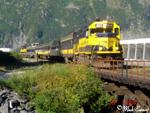 |
GP40-2 3009 leading
the Glacier Discovery Train arrives at Whittier at 12:35 pm with Baggage
111, Coach 210, Coach 206, Dome 525, and GP40-H 3013. |
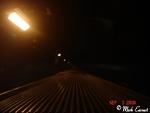 |
Inside Anton Anderson from the dome
of ex-Montana Rockies Rail Tours (MRRT) Dome 525 exiting Whittier at 1:00
pm. |
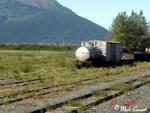 |
Passing by the four-track storage
yard just outside Portage at 1:15 pm featuring an old tank car and ex-Navy
box car, which was built by Pressed Steel, Thrall, Pullman Standard sometime
between 1943 and 1957. What a treat for us freight fans! |
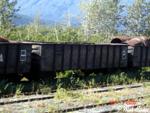 |
The 41-foot gondolas #13312 &
#13347 with a load of scrap were built by Mt. Vernon Car Manufacturing Co.
in 1943. They were purchased from D&RGW in 1947. |
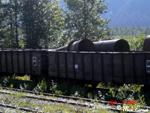 |
|
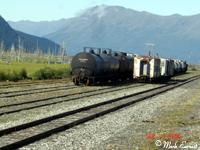 |
Tank cars and miscellaneous MOW
equipment including ex-troop transport cars converted to an outfit tool
car (1306E), outfit flat car (0047), outfit water car (1569E), and outfit
bath car (1000E). |
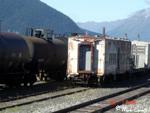 |
|
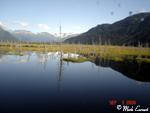 |
Entering EART Block near Portage. |
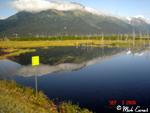 |
View from EART Block. Note the dead
trees which are typical of the Portage area. They are casualties of the
1964 Good Friday Earthquake when the ground in this area dropped up to eight
feet, thereby allowing salt water to infiltrate the root systems through
groundwater and high tides (other areas in the Prince William Sound rose
an incredible 38 feet!). |
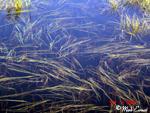 |
Art picture alert! Quick, skip this
one to get back to the really good stuff. |
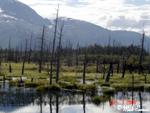 |
Oops…another art pic - this one with dead trees. Don't know how this
one slipped in. |
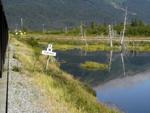 |
Backing into Portage at 1:35 pm. |
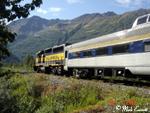 |
Say goodbye to 3013 and hello to our next mode of transportation at 1:55
pm…. |
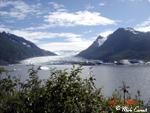 |
Spencer Glacier and Spencer Lake. |
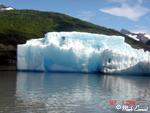 |
Rafting around ice chunks from the
glacier at 3:05 pm. |
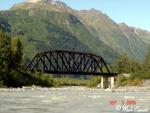 |
Approaching Placer River bridge
at 3:25 pm. |
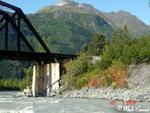 |
Placer River bridge pier. |
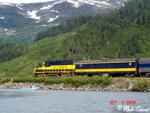 |
What a welcome sight! #3009 heading
to our rendezvous site. |
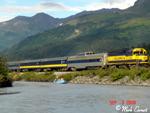 |
#3013 and our traveling companion
raft. |
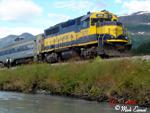 |
#3013 is idling while we paddle
up. |
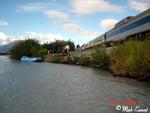 |
There are even e-z steps for the
rafters. |
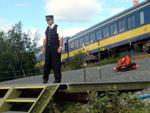 |
The end of our wonderful float trip.
Conductor Sherwood lends a hand to the rafters at 5:00 pm. |
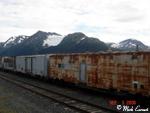 |
Back to the good stuff: passing
MOW cars on our return from Portage to Whittier at 5:30 pm. |
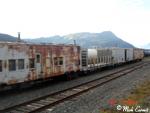 |
|
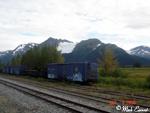 |
Here are three sixty-foot PC&F
insulated box cars, led by 10821, mixed in with non-interchange 41- and
65-foot gondolas. The ARR purchased 35 of these distinctive box cars in
1965. |
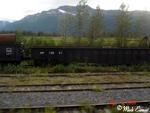 |
This 70-ton, 65' mill gondola (#13841)
was built by Pressed Steel Car Co. in 1944 and was acquired by the ARR in
1947. |
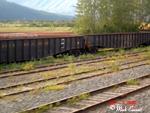 |
Two more of the 65' mill gondola,
including #13828. |
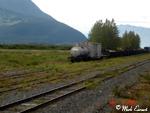 |
One last view of the freight cars
on the multi-track siding outside of Portage. |
Back
© 2006 Mark Earnest



























